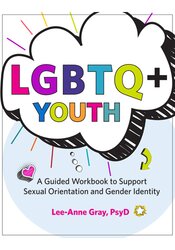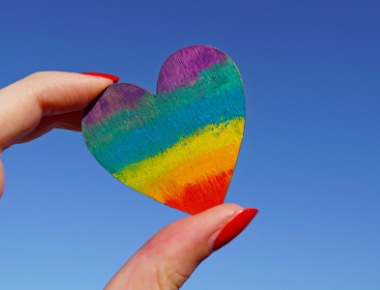Celebrating Gender Identity with Youth Clients
FREE LGBTQ+ Youth worksheets

Clinicians and educators will work with an extremely diverse group of young people over their careers. Each student and client will vary tremendously in upbringing, family life, interests, and personality. It’s no secret that individuals will identify anywhere across the gender identity spectrum as well!
Sexual orientation is so much more than being gay, straight, or bisexual. Gender identity is a spectrum far outside the binary of male and female, and likewise, sexuality takes on many dimensions too. It’s imperative that clinicians and educators explore sexuality beyond the binary with their clients, as the gray area between heterosexuality and homosexuality is where many clients will self-identify.
It’s essential to be aware that there are more dimensions to sexuality than some clinicians, educators, and parents typically think of. For example, bisexuality relates to the binary of gender, meaning that a bisexual individual is attracted to both men and women. Pansexual, omnisexual, or polysexual individuals experience attraction to a wider range of gender identities and human qualities.
Today’s youth are increasingly aware that there are a wide variety of sexual and gender identities, and it can be helpful for clinicians and educators to nurture them as they explore different labels. is a clinical tool to help clients explore many healthy variations of human love, sex and attraction and which is right for them. They can use this tool, in or out of session, to figure out where on the spectrum they lie at this particular moment—knowing that it may change or stay the same. Finding ways of exploring this topic with youth clients will help to cultivate and celebrate sex and body positivity.
Coming out is an important step for some youths to affirm their own identities. It often takes a lot of courage for a young person to come out, especially to family members who may not be accepting. But having a label they can define and explain is helpful for many LGBTQ+ youths. For instance, when 17-year-old Dylan told his parents he is polysexual, they didn’t know what that meant. Dylan could face his parents’ confusion with sensitivity and explain that he is attracted to people regardless of their biological or psychological gender identity. It doesn’t matter to Dylan if he is with a guy, a girl, someone who is trans, or someone intersex. He only cares about the attraction and chemistry between them.
Deciding to come out can also be incredibly freeing, rewarding, and self-affirming. If your client is ready and excited to come out and share their gender or sexual identity, help them celebrate with cartwheels and fireworks!
You can help your young clients with questions on gender identity, coming out, and even facing homophobia with these from Lee-Anne Gray, Psy.D. Check out the rest of Gray’s book, , for more practical and engaging tools in your next session with LGBTQ+ Youth.
Sexual orientation is so much more than being gay, straight, or bisexual. Gender identity is a spectrum far outside the binary of male and female, and likewise, sexuality takes on many dimensions too. It’s imperative that clinicians and educators explore sexuality beyond the binary with their clients, as the gray area between heterosexuality and homosexuality is where many clients will self-identify.
It’s essential to be aware that there are more dimensions to sexuality than some clinicians, educators, and parents typically think of. For example, bisexuality relates to the binary of gender, meaning that a bisexual individual is attracted to both men and women. Pansexual, omnisexual, or polysexual individuals experience attraction to a wider range of gender identities and human qualities.
Today’s youth are increasingly aware that there are a wide variety of sexual and gender identities, and it can be helpful for clinicians and educators to nurture them as they explore different labels. is a clinical tool to help clients explore many healthy variations of human love, sex and attraction and which is right for them. They can use this tool, in or out of session, to figure out where on the spectrum they lie at this particular moment—knowing that it may change or stay the same. Finding ways of exploring this topic with youth clients will help to cultivate and celebrate sex and body positivity.
Coming out is an important step for some youths to affirm their own identities. It often takes a lot of courage for a young person to come out, especially to family members who may not be accepting. But having a label they can define and explain is helpful for many LGBTQ+ youths. For instance, when 17-year-old Dylan told his parents he is polysexual, they didn’t know what that meant. Dylan could face his parents’ confusion with sensitivity and explain that he is attracted to people regardless of their biological or psychological gender identity. It doesn’t matter to Dylan if he is with a guy, a girl, someone who is trans, or someone intersex. He only cares about the attraction and chemistry between them.
Deciding to come out can also be incredibly freeing, rewarding, and self-affirming. If your client is ready and excited to come out and share their gender or sexual identity, help them celebrate with cartwheels and fireworks!
You can help your young clients with questions on gender identity, coming out, and even facing homophobia with these from Lee-Anne Gray, Psy.D. Check out the rest of Gray’s book, , for more practical and engaging tools in your next session with LGBTQ+ Youth.
Discover More Ways to Support Sexual Orientation & Gender Identity

Access the most comprehensive, practical, and user-friendly workbook written specifically for clinicians and educators to engage and support lesbian, gay, transgender, bisexual and questioning youth.
Over 75 different concepts, worksheets, handouts and practices based in mindfulness, meditation and self-compassion that help children, adolescents and their caregivers:
Over 75 different concepts, worksheets, handouts and practices based in mindfulness, meditation and self-compassion that help children, adolescents and their caregivers:
- Deal with the challenges of coming out
- Understand sexual identity, gender norms and fluidity
- Safety plan and address negative attitudes at school and in their community
- Explore the world of dating and sexuality for each population
- Road map the transition process for transgender youth
- Know terms & definitions
Meet the Expert:
Lee-Anne Gray, PsyD, is a clinical psychologist, educator, and author. She is certified in EMDR, trauma treatment, as well as a national speaker in self-compassion, mindful awareness, LGBTQ youth, assessment, special education, and gifted individuals.
As the president and CEO of The Connect Group, she serves the global educational community with innovative professional development seminars in empathy, compassion cultivation, Design Thinking, and transformational coaching.
Formerly an instructor of Psychology of Gender in the Department of Psychology/Women’s Studies at UCLA, Dr. Gray has served the LGBTQ community as an ally and through her private practice. She was also forensic expert and independent consultant to the Orange County Public Defender where she evaluated LGBTQ youth in juvenile hall.
Dr. Gray’s latest book, Self-Compassion for Teens: 129 Activities and Practices to Cultivate Kindness (РЎтттЅКУЖµ, 2016), is the first of its kind; a collection drawn from her work with teens at The Connect Group. Self-Compassion for Teens is enthusiastically endorsed by Tara Brach, Christopher Germer, Kelly McGonigal, among others. It was the #1 new release on Amazon, in Child Popular Psychology and Emotional Mental Health, and contains a whole chapter focusing on the unique needs of LGBTQ youth. She is also the author of LGBTQ+ Youth: A Guided Workbook to Support Sexual Orientation and Gender Identity (РЎтттЅКУЖµ, 2018) and the Self-Compassion & Mindfulness for Teens Card Deck: 54 Exercises and Conversation Starters (РЎтттЅКУЖµ, 2017).
Learn more about their educational products, including upcoming live seminars, by clicking here.
As the president and CEO of The Connect Group, she serves the global educational community with innovative professional development seminars in empathy, compassion cultivation, Design Thinking, and transformational coaching.
Formerly an instructor of Psychology of Gender in the Department of Psychology/Women’s Studies at UCLA, Dr. Gray has served the LGBTQ community as an ally and through her private practice. She was also forensic expert and independent consultant to the Orange County Public Defender where she evaluated LGBTQ youth in juvenile hall.
Dr. Gray’s latest book, Self-Compassion for Teens: 129 Activities and Practices to Cultivate Kindness (РЎтттЅКУЖµ, 2016), is the first of its kind; a collection drawn from her work with teens at The Connect Group. Self-Compassion for Teens is enthusiastically endorsed by Tara Brach, Christopher Germer, Kelly McGonigal, among others. It was the #1 new release on Amazon, in Child Popular Psychology and Emotional Mental Health, and contains a whole chapter focusing on the unique needs of LGBTQ youth. She is also the author of LGBTQ+ Youth: A Guided Workbook to Support Sexual Orientation and Gender Identity (РЎтттЅКУЖµ, 2018) and the Self-Compassion & Mindfulness for Teens Card Deck: 54 Exercises and Conversation Starters (РЎтттЅКУЖµ, 2017).
Learn more about their educational products, including upcoming live seminars, by clicking here.



